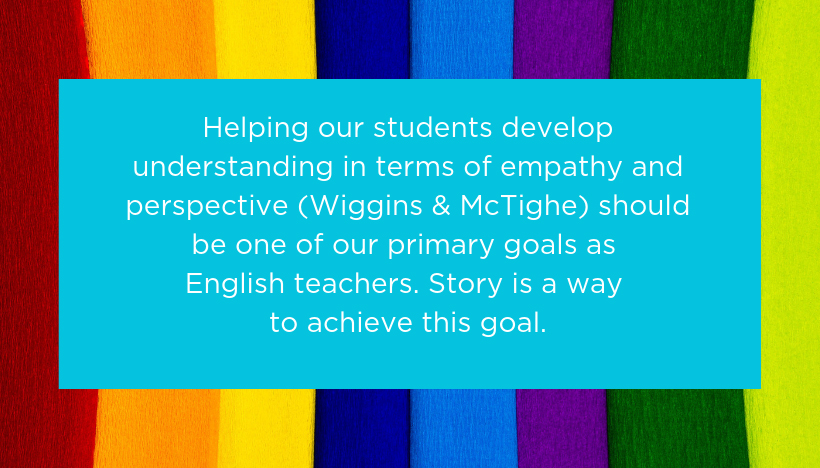From the NCTE LGBTQ Advisory Committee
This blog post was written by Katherine Mason Cramer, a member of the NCTE LGBTQ Advisory Committee.
The Experiences of LGBTQ Students in Middle and High Schools
At the 2019 Kansas Association of Teachers of English’s energizing KATE Camp last month, I attended a session focused on sexual and gender diversity and equity in the classroom. After sharing resources from GLSEN, articles from NCTE journals, and curricular ideas from our own classrooms, our focus turned to how teachers can respond effectively to students’ use of anti-LGBTQ (lesbian, gay, bisexual, transgender, and queer) language. One teacher described how some of his cisgender students would joke around about gender diversity, while other teachers expressed similar frustrations.
According to GLSEN’s 2017 National School Climate Survey, a biennial report that provides data on the experiences of LGBTQ youth, grades 6–12, in US schools, “a distressing number of LGBTQ students . . . routinely hear anti-LGBTQ language and experience victimization and discrimination at school” by both peers and school staff (Kosciw et al., 2018, pp. xviii and 11).
Additionally, “LGBTQ middle school students reported a more hostile school climate than LGBTQ high school students,” including biased language, peer victimization, and anti-LGBTQ discrimination, and yet LGBTQ middle school students were less likely than their high school peers to report having LGBTQ-related resources and supports (Kosciw et al., 2018, p. 109).
With these finding in mind, school districts should provide LGBTQ-inclusive curriculum and resources, “comprehensive anti-bullying policies and supportive transgender/gender nonconforming student policies,” and professional development for educators and administrators to recognize and affirm sexual and gender diversity at the middle school level—while also “addressing anti-LGBTQ bias in the younger grades before it becomes engrained in middle school students’ behaviors and attitudes” (Kosciw et al., 2018, pp. 109-110).
As a former middle school teacher and as someone who recalls her own middle school experience as being both disorienting and disheartening, I know how challenging it can be to promote a classroom and school culture that recognizes and affirms diverse identities and experiences.
As our KATE Camp group collectively mulled over the issue of students’ use of anti-LGBTQ language, two themes emerged which can (and should) be introduced simultaneously: the power of story, and the power of effective classroom management.
The Power of Story
Helping our students develop understanding in terms of empathy and perspective (Wiggins & McTighe) should be one of our primary goals as English teachers. Story is a way to achieve this goal. Excerpts from young adult literature (YAL) and film, picture books, feature news articles, documentaries, and public service advertisements like GLSEN’s 2018 “Hallway” can help students acknowledge and confront hurtful, derogatory language and behavior.
Visibility is also key in curricular inclusion. Rudine Sims Bishop (1990) writes that “when children cannot find themselves reflected in the books they read, or when the images they see are distorted, negative, or laughable, they learn a powerful lesson about how they are devalued in the society of which they are part” (1990).
At the same time, “children from dominant social groups have always found mirrors in books, but they too suffered from the lack of availability of books about others” (Sims Bishop, 1990).
Designing curriculum that integrates the study of sexual and gender diversity alongside all other content helps to interrogate and dismantle the single story. As novelist Chimanda Ngozi Adichie reminds us, “the single story creates stereotypes, and the problem with stereotypes is not that they are untrue but that they are incomplete” (2009). She further impressed this point on us during a General Session at the 2018 NCTE Convention, reminding listeners that the danger of a single story is just as important today as it always has been, citing coverage of immigrants and the murder of journalist Jamal Kashoggi as examples of that importance.
In order to disrupt the single story and provide both mirrors and windows to your students, check out the 2019 Rainbow Book List for recommended picture books, middle grades fiction, and young adult fiction and nonfiction, as well as my article “Clearing Paths for Transgender Identities with Middle Grades Literature” from the December 2018 issue of NCTE’s Voices from the Middle.
The Power of Effective Classroom Management
This curricular inclusion should be accompanied by effective classroom management.
If you have students saying things that are disrespectful or harmful, and they refuse to stop, even when you directly state “That language is unacceptable,” it’s time to use your classroom management plan to encourage them to stop. Whatever escalating consequences you have in place (e.g., verbal warning, seat change, removal from the room, phone call home, after school/lunch detention), implement it for disrespectful and harmful language—alongside opportunities to confer with you about why that language or behavior is hurtful. Rebecca Alber calls this a “non-negotiable” in her Edutopia blog post about creating a safe learning environment.
Enlist the support of colleagues. Check out resources like GLSEN’s ThinkB4YouSpeak Guide for Educators of Grades 6-12 to further educate yourself, your students, and your colleagues. Do not delay. Your students are watching and learning whether or not you are a trusted adult who will stand up for all students.
Start Wielding Your Power
As Dana M. Stachowiak reminds us in a recent NCTE blog post, teachers have the power to make curricular and classroom management decisions that positively impact the well-being and learning of all of our students.
I urge you to make time this summer to determine how you will ensure that your classroom is a safe and welcoming space for all your students. What curricular and classroom management changes do you intend to make?
If your classroom is already a safe space, how can you work with colleagues to expand that safety to other spaces in your school? As YA author Bill Kongisberg has reminded us on numerous occasions, this is a health and safety issue, and as educators we have the responsibility—and the power—to take action.
Check out the links in this post as well as the resources below to help you get started:
- Educator Guides for GLSEN Programs
- Teaching Tolerance’s NEW LGBTQ Best Practices Guide
- Supporting a Gay-Straight Alliance in Middle School
- Supporting LGBTQ Students in Elementary School (these tips are applicable across grade levels)

Katherine Mason Cramer is a former Kansas City, Kansas Public Schools middle school English teacher and is now associate professor and program chair of Middle/Secondary English Education at Wichita State University in Kansas. She can be reached at Katie.Cramer@wichita.edu.

